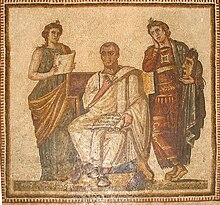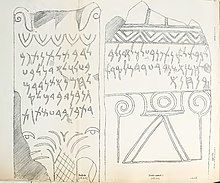Hadrumetum
 | |
| Location | Tunisia |
|---|---|
| Region | Sousse Governorate |
| Coordinates | 35°49′28″N10°38′20″E/ 35.824444°N 10.638889°E |
Hadrumetum,[1]also known bymany variant spellings and names,was aPhoeniciancolonythat pre-datedCarthage.It subsequently became one of the most important cities in Roman Africa beforeVandalandUmayyadconquerors left it ruined. In the early modern period, it was the village ofHammeim,now part ofSousse,Tunisia.
A number of punic steleswere found during excavations at the site of the modern dayÉglise Notre-Dame-de-l'Immaculée-Conception de Sousse[fr].
Names[edit]
ThePhoenicianandPunicname for the place wasDRMT(𐤃𐤓𐤌𐤕), "Southern", orʾDRMT(𐤀𐤃𐤓𐤌𐤕), "The Southern", which holds similarity to the hebrew wordדרום"Darom" (south) or Ha-Dromit ( "The southern" ).[2]A similar structure appears in the Phoenician name for oldCadiz,which appears asGadir( "Stronghold" ) orAgadir( "The Stronghold" ).
The ancient transcriptions of the name show a great deal of variation. DifferentGreekshellenizedthe name asAdrýmē(Ἀδρύμη),[3]Adrýmēs(Ἀδρύμης),Adrýmēton(Ἀδρύμητον),[2]Adrýmētos(Ἀδρύμητος),Adramýtēs(Ἀδραμύτης),Adrámētós(Ἀδράμητος)[1]andAdrumetum(Ἀδρούμητον).[4]Surviving Roman inscriptions and coinage standardized itslatinizationas Hadrumetum[1]but it appears in other sources asAdrumetum,[3]Adrumetus,[5]Adrimetum,Hadrymetum,etc.[1]Upon its notional refounding as aRoman colony,its formal name was emended toColonia ConcordiaUlpia Trajana AugustaFrugifera Hadrumetinato honor its imperial sponsor.[1]
It was renamedHonoriopolisafter the emperorHonoriusin the early 5th century,[citation needed]thenHunericopolisafter the Vandal kingHuneric[6]andJustinianopolis[3]after the Byzantine emperorJustinian I.
Geography[edit]
Hadrumetum controlled the mouth of a small river[7]on theGulf of Hammamet(Latin:Sinus Neapolitanus), an inlet of theMediterraneanalong theTunisiancoast.[1]
History[edit]
Phoenician colony[edit]
In the 9th centuryBC,[citation needed]Tyriansestablished Hadrumetum[1]as a trading post and waypoint along their trade routes toItalyand theStrait of Gibraltar.Its establishment precededCarthage's[8]but, like other westernPhoenician colonies,it became part of theCarthaginian Empire[1]followingNebuchadnezzar II'slong siege of Tyrein the 580s and 570sBC.
Carthaginian city[edit]

Agathocles of Syracusecaptured the town in 310BC[1]during theSeventh Sicilian War,as part of his failed attempt to move the conflict to Africa. Hadrumetum later provided refuge toHannibaland other Carthaginian survivors after their202BC defeat at Zama,[1]which decided the outcome of theSecond Punic War.The total length of the Punic fortifications was apparently 6,410 meters (21,030 ft); some ruins survive.[9]
Roman city[edit]
During theThird Punic War,the government of Hadrumetum supported theRomansagainst Carthage[10]and, afterCarthage's destruction in 146BC,it received additional territory andthe status of a free cityin thanks.[11]During this period, it chose its ownshufets(Latin:duumvir) and minted its ownbronzecoins with the head of "Neptune"or the Sun.[9]
During thecivil warbetweenPompeyandJulius Caesar,G. Considius Longussecured Hadrumetum for theOptimateswith forces equivalent to twolegions.Despite being reinforced byGn. Calpurnius Piso'sBerbercavalry and footmen fromClupea,however, he was obliged to allow Caesar to land nearby on 28 December 47BC.[12]According toSuetonius,this landing was the occasion of the famously deft recovery, when Caesar tripped while coming ashore but dealt with the pooromenby grabbing handfuls of dirt and proclaiming "I have you now, Africa!" (Latin:teneo te Africa)[13]Caesar's attempts to negotiate with Longus were rejected but the campaign subsequently led tohis victoryoverMetellus ScipioandJubaatThapsus,after which Longus was killed by his own men for the money he was carrying[14]and the town went over to Caesar.[15]

Hadrumetum was one of the most important communities inRoman North Africabecause of the fertility of its hinterland (modern Tunisia'sSahel), which made it an important source ofRome's grain supply.It quarreled with its neighborThysdrusover the temple of a goddessequated toMinerva,which stood on their shared border.[1]
UnderAugustus,Hadrumetum's coins bore his faceobverseand the name (and often face) of Africa's proconsulreverse;after Augustus, the mint was closed.[9]Hadrumetum revolted whileVespasianwasproconsulofAfrica.[16]It nonetheless continued to prosper;Trajangave it the rank of aRoman colony,giving its residentsRoman citizenship.[3]A breathtaking legacy of intricatemosaicssurvives from this era, together with many early Christian objects from thecatacombs.It was the second city in Roman Africa afterCarthageand the birthplace ofClodius Albinus,who attempted to becomeemperorin the 190s.[9]At the end of the 3rd century, it became the capital of the new province ofByzacena[5](modernSahel, Tunisia).
Later history[edit]
In 434, it was largely destroyed by theVandals;[5][9]their ferventArianismproduced a number of orthodox martyrs in the remaining community, includingSSFelixandVictorian.A century later, Hadrumetum was retaken and rebuilt by theByzantinesduring theVandal War.[17]It wasconqueredby theUmayyad Caliphatein the 7th century.
The ruins of Hadrumetum stood in the village of Hammeim,[3]10 kilometers (6 mi) from the laterSousse,[7]which grew up to include them in its outskirts.
Undercolonial rule,the French engineer A. Daux[which?]rediscovered thejettiesandmolesof the Roman town's commercial harbor and the line of its military harbor; both had been mostly artificial and havesilted upsince antiquity.[9]Louis Cartonand AbbéLeynaud[which?]rediscovered theChristiancatacombsin 1904; the tunnels extend for miles through small subterranean galleries filled with Roman and Byzantinesarcophagiand inscriptions.[9]
Ruins[edit]
In addition to thePunicwalls, Roman harbors, and Byzantine catacombs, there are ruins of the Byzantine acropolis andbasilica;the Romanhorse track,cisterns,thetheater;and a Punicnecropolis.[9]
Religion[edit]
As a major Roman city, Hadrumetum produced a number ofChristian saints,includingMavilusduring theregional persecutionsofCaracalla's reign and the BishopFelixand proconsulVictorianduring theVandals' efforts toforcibly converttheir subjects toArianism.From 255 to 551, the city was theseatof aChristianbishopric.The see was revived in the 17th century as aCatholictitular see.
List of bishops[edit]
There were nine ancient bishops of Hadrumetum who are still known.[5]
- Polycarp,who appeared at the256 Council of Carthage[18]
- StFelix,martyredbyGaiseric
- StPrimasius
- Raphael de Figueredo (1681.05.14 – 1695.10.12)
- Salvator-Alexandre-Félix-Carmel Brincat (1889.05.12 – 1909.04.02)
- Giacinto Gaggia (1909.04.29 – 1913.10.28)
- Jean-Marie Bourchany (1914.01.13 – 1931.11.27)
- Carlo Re,IMC(1931.12.14 – 1951.12.29)
- Jorge Manrique Hurtado (1952.02.23 – 1956.07.28)
- Celestin Bezmalinovic,OP(1956.08.07 – 1967)
- Mijo Škvorc,SJ(1970.06.16 – 1989.02.15)
- Marian Błażej Kruszyłowicz,OFM Conv(1989.12.09 – present)
References[edit]
Citations[edit]
- ^abcdefghijkEnc. Brit.(1911),p. 802.
- ^abMaldonado López (2013),pp. 43–45.
- ^abcdeNew Class. Dict.(1860),s.v."Hadrūmētum".
- ^Harry Thurston Peck, Harpers Dictionary of Classical Antiquities (1898), Hadrumētum
- ^abcdCath. Enc.(1910).
- ^O. Maenchen-Helfen,The World of the Huns.IX. footnote 113.
- ^abNorie (1831),p.348.
- ^Sallust,Jug.,19.
- ^abcdefghEnc. Brit.(1911),p. 803.
- ^Appian,The Punic Wars,§94.
- ^CIL,Vol.I, p.84.
- ^Caesar& al.,Afr. War,Ch.iii.
- ^Suetonius,Div. Jul.,§59.(in Latin)&(in English)
- ^Caesar & al.,Afr. War,§76.
- ^Caesar & al.,Afr. War,§89.
- ^Suetonius,Vesp.,Ch. iv.
- ^Procop.,Build., Book VI, §6.
- ^Cyprian."Epistle LIII".andrews.edu.RetrievedFeb 16,2022.
Bibliography[edit]
- A New Classical Dictionary of Greek and Roman Biography, Mythology, and Geography,New York: Harper & Bros, 1860.
- Babelon, Ernest Charles François(1911)..InChisholm, Hugh(ed.).Encyclopædia Britannica.Vol. 12 (11th ed.). Cambridge University Press. pp. 802–803.
- Maldonado López, Gabriel (2013),Las Ciudades Fenicio Púnicas en el Norte de África...(PDF).(in Spanish)
- Norie, J.W. (1831),New Piloting Directions for the Mediterranean Sea...,London: J.W. Norie & Co.
- Pétridès, Sophrone (1910),"Hadrumetum",Catholic Encyclopedia,vol.VII, New York: Robert Appleton Co.
External links[edit]
- Sousse (Sūsa)Archived2008-12-11 at theWayback MachineEncyclopaedia of the Orient
- Adventures of Tunisia: A virtual tour of the historic sites of SousseArchived2008-09-22 at theWayback Machine
- GigaCatholic, with titular incumbents lists and linked biographies


